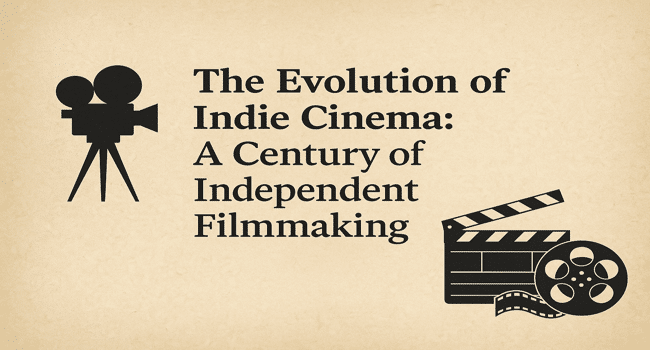Table of Contents
Independent cinema and today’s live movies Has long stood as an alternative to mainstream Hollywood, permitting filmmakers greater creative freedom and numerous storytelling opportunities. Over the a long time, indie filmmaking has evolved alongside technological advancements, cultural shifts, and new distribution strategies.
Let’’s assessment the primary eras.
Early Origins: Breaking Away from the System
The roots of impartial film trace lower back to the early1900s, while filmmakers sought creative and economic freedom from Edison’s Motion Picture Patents Company (MPPC). This monopoly controlled film production and distribution, forcing impartial creators to perform outside the gadget. Many relocated to Hollywood, far from Edison’s prison attain, in which they laid the foundation for what would come to be the modern-day movie enterprise.
A key turning factor got here in 1919, while Charlie Chaplin, Mary Pickford, Douglas Fairbanks, and D.W. Griffith based United Artists, aiming to provide filmmakers manipulate over their very own productions. Though United Artists faced demanding situations, its creation symbolized a lasting motion towards independent filmmaking.
Mid-20th Century: The Rise of Art House and Experimental Film
By the 1940s and ‘50s, Hollywood’s studio gadget dominated the enterprise, however impartial filmmakers began to carve out their area. The Supreme Court’s Paramount Decision (1948) compelled studios to separate movie manufacturing from theater ownership, weakening their grip on distribution and commencing doors for smaller productions.
This technology noticed the upward push of avant-garde and documentary filmmaking, with pioneers like Maya Deren, Kenneth Anger, and John Cassavetes rejecting commercial formulation in favor of inventive expression. Cassavetes’ Shadows (1959) have become a landmark in indie cinema, embracing improvisation and raw performances that felt extra authentic than polished Hollywood productions.
The Nineteen Seventies: Indie Film Meets New Hollywood
The New Hollywood motion blurred the strains between unbiased and studio filmmaking. Hollywood, in a kingdom of disaster, grew to become to unconventional directors, many of whom had emerged from unbiased film. Francis Ford Coppola, Martin Scorsese, George Lucas, and Steven Spielberg ushered in an generation in which character-pushed, danger-taking movies observed mainstream audiences.
Meanwhile, impartial filmmakers endured operating outside the gadget, developing low-budget style movies that would advantage cult followings. Horror films like The Texas Chain Saw Massacre (1974) and Halloween (1978) have been made with minimal sources however proved that independent productions could gain mainstream achievement.
The 1980s: Setting the Stage for Modern Indie Film
The Eighties performed a critical function in establishing the impartial movie enterprise as we are aware of it today. Two primary institutions helped legitimize indie filmmaking:
- The Sundance Film Festival – Originally the U.S. Film and Video Festival, Robert Redford relaunched it as Sundance in 1985. It quickly have become a first-rate platform for unbiased movies.
- The Independent Spirit Awards – Founded in 1986, these awards identified movies that deviated from Hollywood’s system, celebrating creativity and originality.
Films like Jim Jarmusch’s Stranger Than Paradise (1984) and Spike Lee’s She’s Gotta Have It (1986) gained important and business attention, proving that independent films could be triumphant out of doors area of interest audiences.
The Nineteen Nineties: The Indie Film Boom
The 1990s noticed impartial cinema explode into mainstream tradition. Sundance have become a launchpad for breakthrough movies, even as distributors like Miramax, New Line Cinema, and Fox Searchlight brought indie movies to a worldwide audience.
The field office fulfillment of Quentin Tarantino’s Pulp Fiction (1994) at Cannes proved that impartial movies could be as financially a success as Hollywood blockbusters. Other movies like Kevin Smith’s Clerks (1994) and Paul Thomas Anderson’s Boogie Nights (1997) established that small-finances productions could captivate audiences with sharp communicate and unconventional storytelling.
At the identical time, virtual technology was making filmmaking greater available. Directors like Richard Linklater and Robert Rodriguez produced movies on micro-budgets, paving the way for the following generation of indie creators.
The 2000s to Present: The Streaming Era and New Challenges
By the early 2000s, independent cinema faced both new possibilities and challenges. Major studios acquired indie corporations—Disney sold Miramax, whilst Fox Searchlight became part of 20th Century Fox—blurring the lines between “impartial” and “studio-subsidized” movies.
At the same time, virtual filmmaking and on line distribution transformed how indie movies had been made and visible. Platforms like YouTube, Vimeo, Netflix, and Amazon Prime made it viable for unbiased films to reach worldwide audiences without traditional theatrical releases.
However, the ones adjustments moreover brought new difficulties, inclusive of an oversaturated market and greater hard opposition. With highly renowned films like Moonlight (2016), Parasite (2019), and Nomadland (2020) demonstrating that independent cinema is still a force to be reckoned with, unbiased films have managed to survive in spite of this.
Conclusion: The Future of Independent Cinema
Independent cinema has always been a space for artistic freedom, imparting a platform for voices often omitted via mainstream Hollywood. As generation and distribution fashions retain evolving, indie filmmakers will want to evolve to new realities even as staying authentic to their creative vision.
The enterprise faces challenges in investment and discoverability, but movie fairs, digital systems, and alternative financing methods like crowdfunding make certain that independent filmmakers nevertheless have ways to create and percentage their paintings. As lengthy as there are testimonies to inform out of doors Hollywood’s constraints, impartial cinema will remain an vital a part of film subculture.
Read more on KulFiy
